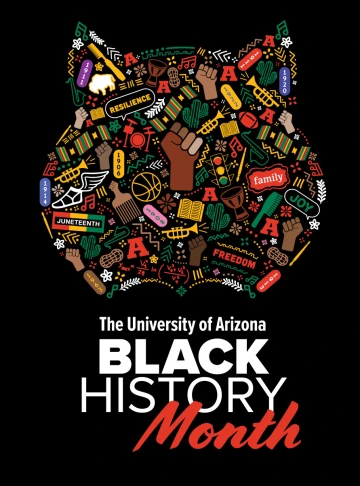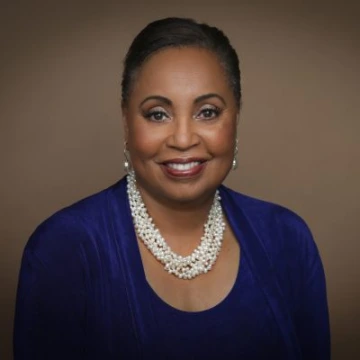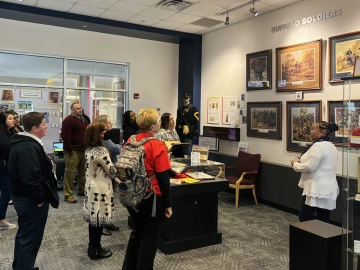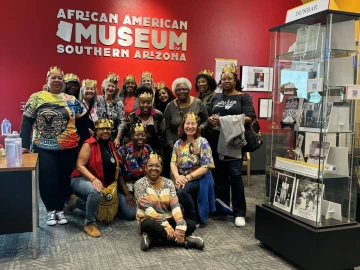
At the University of Arizona, we are proud to recognize and celebrate our distinct cultures and communities year-round. National Black History Month (February) presents the opportunity to highlight the contributions, creativity, and legacy of the Black community.
Q&A with African American Museum of Southern Arizona Executive Director Beverely Elliott
Michael Pisetsky Research, Innovation & Impact
The African American Museum of Southern Arizona (AAMSAZ) just celebrated its second anniversary, could you reflect a little on the growth of the museum in that time?
We're excited and feel truly blessed that the community has come out to support the museum, because we wouldn't be able to grow without the community. We initially opened our doors on January 14 of 2023 so we are just celebrating that second year, and in that time, we have had over 7,000 visitors in an 1,100 square foot space. We went from five exhibits, which was kind of interesting, because with only five exhibits, the very first opening, we had 362 people, so we felt really kind of overwhelmed initially that there was that much interest. We have grown from those five exhibits to 15. We have about three or four more that we could probably put out, but in all honesty, we're almost out of space, so that's a good thing. We have applied for additional space on campus, and the growth has been phenomenal.
We're members of the Museum Association of Arizona. We have been certified by the Arizona Historical Society, which is unusual. Most places take quite some time to be certified. We were certified in 18 months. Most take five to 10 years, so we've been we're moving very quickly.
What are some collaborations that have made your growth so strong?

Beverely Elliott, executive director of AAMSAZ
We are such a small museum and we're pretty full, so we can't really host anything there. We reach out to the community where we can assist with different programs. We collaborate with Raytheon, where they just had a gala to kick off Black History Month. We have also coordinated with the College of Medicine’s Black Men in White Coats at a Martin Luther King Day celebration, which was a basketball tournament put on by Tucson Unified School District. We were there for “A Time Out for History”. When there was a time out, there was a little blurb about the museum. There's a group called ABC, A Better Community. They do programs monthly at the Dunbar Pavilion and we have been supporters of that for the last couple of years.
We also have collaborated with the NAACP as well as the W.A. Franke Honors College. We are also collaborating with the University of Arizona Museum of Art.
We are also very proud that we've received a proclamation from the City of Tucson in honor of Black History Month this year, and we will be present at the Pima County Board of Supervisors meeting, where they will also provide us with the proclamation. We are partners with the Fox Theater, so when they have a group that comes in that's African American or performs gospel or soul music or theatrical performances, we make sure that we get our community out to support that. We have been doing the same thing with Broadway of Tucson, so we are collaborating with a lot of people in the community as well as on campus.
AAMSAZ has long been focused on community engagement, how do you support community members and make it clear that anyone can contribute to the museum?
We are doing a lot of things where we work with people from all around the country. We have several amazing stories. Everything in that museum that has a name is part of someone's family. We want to make sure people understand we're family friendly, and we have been able to connect people who have found their family on our website, believe it or not, from different parts of the country. There is an example about a man, Clarence Harper. His aunt raised him, her name was Janet Harmon Bragg. She was the first African American woman to get a pilot's license in the United States. Now, there was a female pilot named Bessie Coleman before then, but she got her license in France. This woman got hers in the United States, and she moved to Tucson. She raised her nephew here, she passed away here, and they're going to be inducting her into the National Women's Aviation Hall of Fame. Well, guess how they found this nephew, they found him because they Googled her family and AAMSAZ popped up. We connected this family to the National Women's Aviation Hall of Fame, and next month, they will present their aunt because she had no children at her induction.
We have a story about a gentleman who brought us a $20 Confederate dollar. This gentleman worked for six months to earn that money after the end of slavery. Of course, Confederate money was no good, so he was paid in funds that were worthless after six months of work. He made sure somebody wrote down the story and to express to his family, moving forward, that everyone needed to be educated. The gentleman who brought this story to us was very proud to say he had a PhD, considering his great, great grandfather was an enslaved man who was uneducated.
Those are the kind of stories that we have been privy to and a part of that we cannot say enough about how the museum has been a connector with the community at large and with the United States. We've received a proclamation from Senator Warnock in Georgia, United States House Representative Claiborne and various other African Americans in the U.S. House and the Senate on the accomplishments of the museum in such a short time.

A tour group learns about the Buffalo Soldiers.
What is the role of AAMSAZ in commemorating Black History Month?
Our role is, of course, to bring attention and to integrate African American and Black history with American history, because it is American history, but oftentimes it's been deleted. Sometimes on purpose, it's been left out. It's been hidden. And what we want to do at the museum is to bring African American history in this area to light. We want people to know that, yes, there might have been battles with our Indigenous brothers and sisters and during the late 1800s early 1900s. Those wars were being led by Buffalo Soldiers and so and that is something we've had to atone for at some point. But the majority of the men who became Buffalo Soldiers were formerly enslaved men who were used to following orders, so to speak. We want to bring some of those things to light.
We also want to bring to light people like Quincy Douglas, an African American woman who had a lot to do with starting the bus system in Tucson. We have national stories like Fred Snowden. A lot of people want to say Tucson became a basketball town when Lute Olson stopped here. Well, people forget about Fred Snowden, who came here and actually his teams paid for McHale Center and the U of A library.
We were a part of lobbying for Mansfield Park to be changed to the Doris J Thompson Park as well as the Ford Park. These individuals had an impact on the city, and people may not know the stories of why these parks are named after them. We want people to understand that it's not just Jesse Owens Park. Who was Jesse Owens, and why is that park named after him, and that's a part of Black history. That's a part of the history of Southern Arizona, and those are the things that most people are not going to hear about in their classroom.
There are countless events going on for Black History Month. Could you highlight some that students and faculty should be aware of?

A group wears crowns following a tour of AAMSAZ.
We’d love for students and faculty to head over to the U of A library. We are in partnership with U of A Libraries and the Library of Congress, to encourage participants to transcribe some of the diaries of famous African Americans, people like W.E.B. DuBois, Frederick, Douglass, Ida B. Wells. You will learn a lot about them as you're transcribing them. It's an electronic transcription at several colleges across the country, so they'll take your transcription of Frederick Douglass along with somebody from the University of Michigan or University of Connecticut, and try to figure out what they said. The Library of Congress will release this information, and you'll be able to read exactly what was going on with them, because they kept these diaries. I think that's probably one of the most interesting things that we have collaborated on. We did it last year, and we're doing it this year.
On Feb 15, there's a debut of the Thomas Willis Harris art retrospective. It's called Love Over Rules, and that is at the U of A Museum of Art. It is an amazing look at how an African American artist interprets different things, whether it's a maze of life, a quilt of life or the Statue of Liberty. I encourage people to check that out as well. On the Feb. 19 at the U of A women's basketball game, U of A Black Alumni will be presented with an honor. They are also serving soul food, so you can go and get a ticket have some soul food and watch Adia Barnes beat up on BYU.
With the Fox Theater, our Grammy Award winning Blind Boys of Alabama will be in concert Thursday, February 20. We're really excited to have them here as a Grammy Award winners. February 25 we're having what's called the “Right to Read” at Utterback Middle School. We encourage parents and friends to bring their children. They're having prizes, books, reading – we think it'll be a lot of fun. February 27 a group called Syncopated Ladies will also be at the Fox Theater. They'll be talking about the lost art of tap dancing with a historical look back at some of the famous tap dancers and talking to them about dance and music. We have quite a few things that we're involved in.
Your slogan “We are a movement, not just a museum,” is a powerful one. Why is it important to emphasize this aspect of the museum and how does AAMSAZ balance the past with the present?
Historically, there have been issues that we need to address that are still here. For example, we were involved with a grant with Dr Jason Jurjevich at the university, and the grant was called Mapping Racist Covenants. There are still several covenants and restrictions on who can live where, believe it or not. We helped bring it to the light that there was redlining, as people may understand more about that term, but basically some of that language is still in your deeds. The reason we are a movement is because we, along with several other groups, took this to the governor, and she signed House Bill 1432 that racist language would need to be removed moving forward from any homeowners association deeds. We are very involved with Love of Reading Week to make sure children have books to read during the summer.
One of the things we're probably most proud of is that we were involved with the signing of the executive order based on the Crown Act for the State of Arizona. Of course, during September, October, November, we're about getting out the vote. We're not telling you who to vote for, we just ask you, as citizens of this country, you have a right to vote after a certain age, and you have a right to learn about what's going on in our country, in our city, in our county, and that you need to be educated about that. Martin Luther King was doing the same thing. Years before that, it was the women's suffragettes. These are things that have been around for a long time. It's not like we are reinventing the wheel. We're just taking it in 2025 and moving it forward and bringing it to the light that these issues still exist. So that's why that's our tagline.

